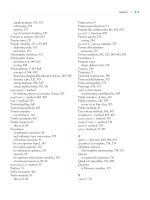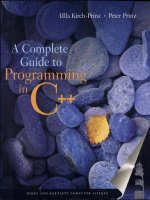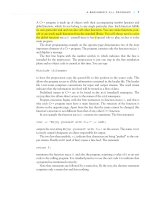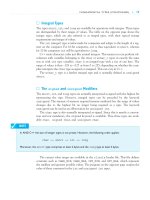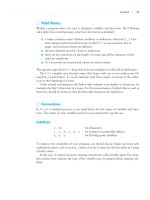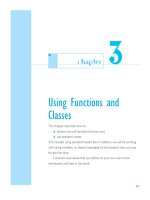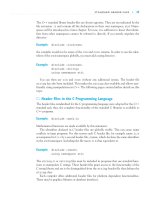A Complete Guide to Programming in C++ part 4 pot
Bạn đang xem bản rút gọn của tài liệu. Xem và tải ngay bản đầy đủ của tài liệu tại đây (234.24 KB, 10 trang )
A BEGINNER’S C++ PROGRAM
■
9
A C++ program is made up of objects with their accompanying member functions and
global functions, which do not belong to any single particular class. Each function fulfills
its own particular task and can also call other functions. You can create functions your-
self or use ready-made functions from the standard library. You will always need to write
the global function main() yourself since it has a special role to play; in fact it is the
main program.
The short programming example on the opposite page demonstrates two of the most
important elements of a C++ program. The program contains only the function main()
and displays a message.
The first line begins with the number symbol, #, which indicates that the line is
intended for the preprocessor. The preprocessor is just one step in the first translation
phase and no object code is created at this time. You can type
#include <filename>
to have the preprocessor copy the quoted file to this position in the source code. This
allows the program access to all the information contained in the header file. The header
file iostream comprises conventions for input and output streams. The word stream
indicates that the information involved will be treated as a flow of data.
Predefined names in C++ are to be found in the std (standard) namespace. The
using directive allows direct access to the names of the std namespace.
Program execution begins with the first instruction in function main(), and this is
why each C++ program must have a main function. The structure of the function is
shown on the opposite page. Apart from the fact that the name cannot be changed, this
function’s structure is not different from that of any other C++ function.
In our example the function main() contains two statements. The first statement
cout << "Enjoy yourself with C++!" << endl;
outputs the text string Enjoy yourself with C++! on the screen. The name cout
(console output) designates an object responsible for output.
The two less-than symbols, <<, indicate that characters are being “pushed” to the out-
put stream. Finally endl (end of line) causes a line feed. The statement
return 0;
terminates the function main() and also the program, returning a value of 0 as an exit
code to the calling program. It is standard practice to use the exit code 0 to indicate that
a program has terminated correctly.
Note that statements are followed by a semicolon. By the way, the shortest statement
comprises only a semicolon and does nothing.
10
■
CHAPTER 1 FUNDAMENTALS
/******************************************************
A program with some functions and comments
******************************************************/
#include <iostream>
using namespace std;
void line(), message(); // Prototypes
int main()
{
cout << "Hello! The program starts in main()."
<< endl;
line();
message();
line();
cout << "At the end of main()." << endl;
return 0;
}
void line() // To draw a line.
{
cout << " " << endl;
}
void message() // To display a message.
{
cout << "In function message()." << endl;
}
■
STRUCTURE OF SIMPLE C++ PROGRAMS
A C++ program with several functions
Screen output
Hello! The program starts in main().
In function message().
At the end of main().
STRUCTURE OF SIMPLE C++ PROGRAMS
■
11
The example on the opposite page shows the structure of a C++ program containing
multiple functions. In C++, functions do not need to be defined in any fixed order. For
example, you could define the function message() first, followed by the function
line(), and finally the main() function.
However, it is more common to start with the main() function as this function con-
trols the program flow. In other words, main() calls functions that have yet to be
defined. This is made possible by supplying the compiler with a function prototype that
includes all the information the compiler needs.
This example also introduces comments. Strings enclosed in /* . . . */ or start-
ing with // are interpreted as comments.
EXAMPLES:
/* I can cover
several lines */
// I can cover just one line
In single-line comments the compiler ignores any characters following the // signs up
to the end of the line. Comments that cover several lines are useful when troubleshoot-
ing, as you can use them to mask complete sections of your program. Both comment
types can be used to comment out the other type.
As to the layout of source files, the compiler parses each source file sequentially,
breaking the contents down into tokens, such as function names and operators. Tokens
can be separated by any number of whitespace characters, that is, by spaces, tabs, or
new line characters. The order of the source code is important but it is not important
to adhere to a specific layout, such as organizing your code in rows and columns. For
example
void message
( ){ cout <<
"In function message()." <<
endl;}
might be difficult to read, but it is a correct definition of the function message().
Preprocessor directives are one exception to the layout rule since they always occupy a
single line. The number sign, #, at the beginning of a line can be preceded only by a
space or a tab character.
To improve the legibility of your C++ programs you should adopt a consistent style,
using indentation and blank lines to reflect the structure of your program. In addition,
make generous use of comments.
exercises
12
■
CHAPTER 1 FUNDAMENTALS
#include <iostream>
using namespace std;
void pause(); // Prototype
int main()
{
cout << endl << "Dear reader, "
<< endl << "have a ";
pause();
cout << "!" << endl;
return 0;
}
void pause()
{
cout << "BREAK";
}
■
EXERCISES
Program listing of exercise 3
EXERCISES
■
13
Exercise 1
Write a C++ program that outputs the following text on screen:
Oh what
a happy day!
Oh yes,
what a happy day!
Use the manipulator endl where appropriate.
Exercise 2
The following program contains several errors:
*/ Now you should not forget your glasses //
#include <stream>
int main
{
cout << "If this text",
cout >> " appears on your display, ";
cout << " endl;"
cout << 'you can pat yourself on '
<< " the back!" << endl.
return 0;
)
Resolve the errors and run the program to test your changes.
Exercise 3
What does the C++ program on the opposite page output on screen?
solutions
14
■
CHAPTER 1 FUNDAMENTALS
■
SOLUTIONS
Exercise 1
// Let's go !
#include <iostream>
using namespace std;
int main()
{
cout << " Oh what " << endl;
cout << " a happy day! " << endl;
cout << " Oh yes, " << endl;
cout << " what a happy day! " << endl;
return 0;
}
Exercise 2
The corrected places are underlined.
/* Now you should not forget your glasses */
#include <iostream>
using namespace std;
int main()
{
cout << " If this text ";
cout << " appears on your display, ";
cout << endl;
cout << " you can pat yourself on "
<< " the back!" << endl;
return 0;
}
Exercise 3
The screen output begins on a new line:
Dear reader,
have a BREAK!
15
Fundamental Types,
Constants, and Variables
This chapter introduces you to the basic types and objects used by C++
programs.
chapter
2
16
■
CHAPTER 2 FUNDAMENTAL TYPES, CONSTANTS, AND VARIABLES
* without type void, which will be introduced later.
■
FUNDAMENTAL TYPES
Overview
*
bool
char
wchar_t
short
int
long
float
double
long double
For integers
For floating-point
values
For boolean values
For characters
FUNDAMENTAL TYPES
■
17
A program can use several data to solve a given problem, for example, characters, inte-
gers, or floating-point numbers. Since a computer uses different methods for processing
and saving data, the data type must be known. The type defines
1. the internal representation of the data, and
2. the amount of memory to allocate.
A number such as -1000 can be stored in either 2 or 4 bytes. When accessing the
part of memory in which the number is stored, it is important to read the correct number
of bytes. Moreover, the memory content, that is the bit sequence being read, must be
interpreted correctly as a signed integer.
The C++ compiler recognizes the fundamental types, also referred to as built-in types,
shown on the opposite page, on which all other types (vectors, pointers, classes, ) are
based.
ᮀ The Type bool
The result of a comparison or a logical association using AND or OR is a boolean value,
which can be true or false. C++ uses the bool type to represent boolean values. An
expression of the type bool can either be true or false, where the internal value for
true will be represented as the numerical value 1 and false by a zero.
ᮀ The char and wchar_t Types
These types are used for saving character codes. A character code is an integer associated
with each character. The letter A is represented by code 65, for example. The character
set defines which code represents a certain character. When displaying characters on
screen, the applicable character codes are transmitted and the “receiver,” that is the
screen, is responsible for correctly interpreting the codes.
The C++ language does not stipulate any particular characters set, although in gen-
eral a character set that contains the ASCII code (American Standard Code for Informa-
tion Interchange) is used. This 7-bit code contains definitions for 32 control characters
(codes 0 – 31) and 96 printable characters (codes 32 – 127).
The char (character) type is used to store character codes in one byte (8 bits). This
amount of storage is sufficient for extended character sets, for example, the ANSI char-
acter set that contains the ASCII codes and additional characters such as German
umlauts.
The wchar_t (wide character type) type comprises at least 2 bytes (16 bits) and is
thus capable of storing modern Unicode characters. Unicode is a 16-bit code also used in
Windows NT and containing codes for approximately 35,000 characters in 24 languages.
18
■
CHAPTER 2 FUNDAMENTAL TYPES, CONSTANTS, AND VARIABLES
#include <iostream>
#include <climits> // Definition of INT_MIN,
using namespace std;
int main()
{
cout << "Range of types int and unsigned int"
<< endl << endl;
cout << "Type Minimum Maximum"
<< endl
<< " "
<< endl;
cout << "int " << INT_MIN << " "
<< INT_MAX << endl;
cout << "unsigned int " << " 0 "
<< UINT_MAX << endl;
return 0;
}
■
FUNDAMENTAL TYPES (CONTINUED)
Integral types
Sample program
Type Size Range of Values (decimal)
char
unsigned char
signed char
short
unsigned short
long
unsigned long
int
unsigned int
1 byte
1 byte
1 byte
2 byte resp.
4 byte
2 byte resp.
4 byte
2 byte
2 byte
4 byte
4 byte
—128 to +127 or 0 to 255
0 to 255
—128 to +127
—32768 to +32767 resp.
—2147483648 to +2147483647
0 to 65535 resp.
0 to 4294967295
—2147483648 to +2147483647
0 to 4294967295
—32768 to +32767
0 to 65535
